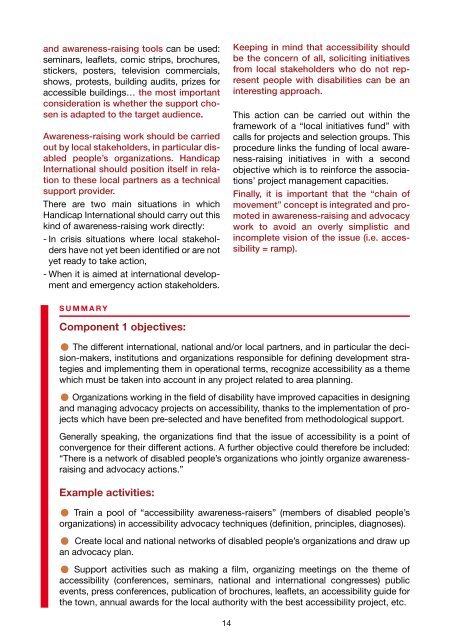Accessibility - Handicap International
Accessibility - Handicap International
Accessibility - Handicap International
You also want an ePaper? Increase the reach of your titles
YUMPU automatically turns print PDFs into web optimized ePapers that Google loves.
and awareness-raising tools can be used:<br />
seminars, leaflets, comic strips, brochures,<br />
stickers, posters, television commercials,<br />
shows, protests, building audits, prizes for<br />
accessible buildings… the most important<br />
consideration is whether the support chosen<br />
is adapted to the target audience.<br />
Awareness-raising work should be carried<br />
out by local stakeholders, in particular disabled<br />
people’s organizations. <strong>Handicap</strong><br />
<strong>International</strong> should position itself in relation<br />
to these local partners as a technical<br />
support provider.<br />
There are two main situations in which<br />
<strong>Handicap</strong> <strong>International</strong> should carry out this<br />
kind of awareness-raising work directly:<br />
- In crisis situations where local stakeholders<br />
have not yet been identified or are not<br />
yet ready to take action,<br />
- When it is aimed at international development<br />
and emergency action stakeholders.<br />
Keeping in mind that accessibility should<br />
be the concern of all, soliciting initiatives<br />
from local stakeholders who do not represent<br />
people with disabilities can be an<br />
interesting approach.<br />
This action can be carried out within the<br />
framework of a “local initiatives fund” with<br />
calls for projects and selection groups. This<br />
procedure links the funding of local awareness-raising<br />
initiatives in with a second<br />
objective which is to reinforce the associations’<br />
project management capacities.<br />
Finally, it is important that the “chain of<br />
movement” concept is integrated and promoted<br />
in awareness-raising and advocacy<br />
work to avoid an overly simplistic and<br />
incomplete vision of the issue (i.e. accessibility<br />
= ramp).<br />
S U M M A R Y<br />
Component 1 objectives:<br />
•<br />
The different international, national and/or local partners, and in particular the decision-makers,<br />
institutions and organizations responsible for defining development strategies<br />
and implementing them in operational terms, recognize accessibility as a theme<br />
which must be taken into account in any project related to area planning.<br />
•<br />
Organizations working in the field of disability have improved capacities in designing<br />
and managing advocacy projects on accessibility, thanks to the implementation of projects<br />
which have been pre-selected and have benefited from methodological support.<br />
Generally speaking, the organizations find that the issue of accessibility is a point of<br />
convergence for their different actions. A further objective could therefore be included:<br />
“There is a network of disabled people’s organizations who jointly organize awarenessraising<br />
and advocacy actions.”<br />
Example activities:<br />
•<br />
•<br />
an advocacy plan.<br />
•<br />
Train a pool of “accessibility awareness-raisers” (members of disabled people’s<br />
organizations) in accessibility advocacy techniques (definition, principles, diagnoses).<br />
Create local and national networks of disabled people’s organizations and draw up<br />
Support activities such as making a film, organizing meetings on the theme of<br />
accessibility (conferences, seminars, national and international congresses) public<br />
events, press conferences, publication of brochures, leaflets, an accessibility guide for<br />
the town, annual awards for the local authority with the best accessibility project, etc.<br />
14

















